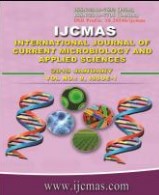


 National Academy of Agricultural Sciences (NAAS)
National Academy of Agricultural Sciences (NAAS)

|
PRINT ISSN : 2319-7692
Online ISSN : 2319-7706 Issues : 12 per year Publisher : Excellent Publishers Email : editorijcmas@gmail.com / submit@ijcmas.com Editor-in-chief: Dr.M.Prakash Index Copernicus ICV 2018: 95.39 NAAS RATING 2020: 5.38 |
Inflammation or infection of the conjunctiva is known as conjunctivitis. Bacterial infections account for up to 50-70% of all conjunctivitis cases. Bacterial conjunctivitis is common and affects all age groups. Clinical evaluation and microbiological analysis is valuable for specific treatment. This study was undertaken to elicit bacterial profile and their antibiotic susceptibility of conjunctivitis. This study was carried out in the departments of Ophthalmology and Microbiology of Mediciti Institute of Medical Sciences, Ghanpur, Hyderabad for period of 3 months. Clinical data and Conjunctival swabs collected from patients with clinically diagnosed as acute conjunctivitis were processed by Gram’s stain, culture and antimicrobial susceptibility testing by standard methods and as Chronic conjunctivitis were processed by Geimsa stain. The data was presented as percentages and proportions. 95% confidence intervals were calculated wherever applicable. All calculations were done using SPSS version 16. Of the total 60 samples processed 15(25%) were sterile. Acute conjunctivitis was seen in 80% while chronic conjunctivitis in 20%. In our study both eyes were affected in 84%. 11 swabs showed more than one isolate. Of the total organisms (56) isolated, majorly were Coagulase negative Staphylococcus (76%) among Gram positive bacteria (88.8%) and majorly Klebsiella species (9%) among Gram negative bacteria (11.1%). The maximum antibiotic sensitivity of the isolates was against ceftazidime (94.20%) followed by Gentamicin (78.8%) while the maximum resistance was against Ampicillin (94.2%) followed by Ciprofloxacin (73.1%). Most bacteria were susceptible to wide range of antibiotics. So, starting the treatment with higher antibiotics should be minimized. However, the choice of antibiotics should be made on the basis of microbiological report.
 |
 |
 |
 |
 |